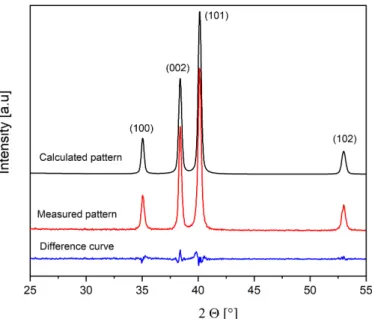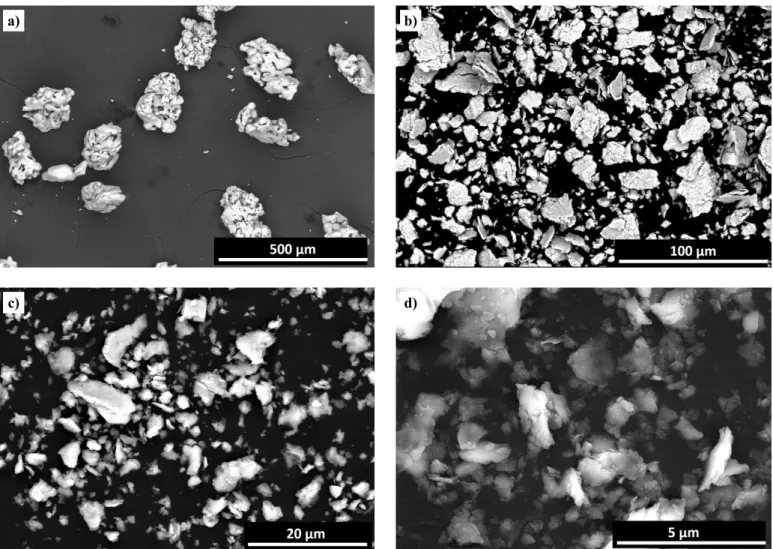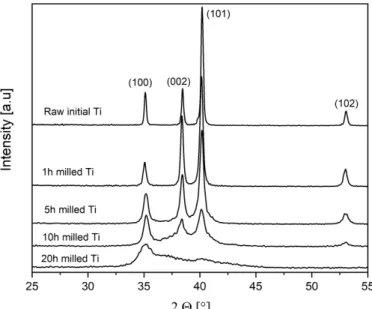BY BY NCNC
© 2020. The Author(s). This is an open-access article distributed under the terms of the Creative Commons Attribution-NonCom- mercial License (CC BY-NC 4.0, https://creativecommons.org/licenses/by-nc/4.0/deed.en which permits the use, redistribution of the material in any medium or format, transforming and building upon the material, provided that the article is properly cited, the use is noncommercial, and no modifications or adaptations are made.
D.A. ANGEL1*, T. MIKO1, M. BENKE1, Z. GACSI1
CHARACTERIZATION OF CERAMIC PARTICLE REINFORCED TITANIUM COMPOSITE PRODUCED VIA POWDER METALLURGY
Nowadays, titanium is one of the most popular materials for aeronautical applications due to its good corrosion resistance, formability and strength. In this paper, rutile reinforced titanium matrix composites were produced via powder metallurgy. The steps included high energy ball milling of raw titanium and rutile powders in a planetary ball mill, which was followed by cold-pressing and sintering without external pressure. For the characterization of the milled powders and the sintered composites, scanning electron microscope, X-ray diffraction and compressive strength examinations were carried out. The results showed that the rutile has a strengthening effect on the titanium matrix. 1 wt% rutile increased the compressive strength compared to the raw titanium.
Increasing the milling time of the metal matrix decreased the compressive strength values.
Keywords: powder metallurgy, titanium, ceramic particle, nanocomposite, mechanical property
1. Introduction
Titanium has been a popular metal during the last decades in the aerospace, automotive industry and in the healthcare also [1]. It exhibits a great balance of formability and the high strength, and besides, titanium also has excellent corrosion re- sistance. It is known that the properties of metals can be further enhanced with decreasing the grain size and decreasing the crystallites size in it to nano scale and producing a nano-sized structure. Another way to improve the properties of the metals, such as the mechanical properties can be, with combining it with ceramic particles and producing composites. Sorkhe at al. [2]
studied the Cu-TiO2 synthesis by thermochemical process and reported the enhanced mechanical properties of the composites.
The advantages of metal matrix composites reinforced with ceramic particles has been studied through many articles, where the main subject was to enhance the mechanical properties of the lightweight metal matrix [3-6]. Issa et al. [4] produced Al-SiO2, Ramachandra et al. [4] Al-ZrO2, Zhang et al. [5] Mg-Al-SiC, Sridhar et al. [6] Mg-Al2O3 nanocomposites via powder metal- lurgy. All the authors reported enhanced mechanical properties compared to the matrix material. Several studies discuss the benefits and mechanical strengthening effects of titanium and ceramic particles combination as composites [7-10]. Lada et al. [7] produced and characterized Ti-ZrO2, Selva Kumar [8]
et al. Ti-TiB, Niespodziana et al. [9] Ti-SiO2 composites with
powder metallurgy techniques. In each research, the improve- ment of mechanical properties was experienced comparing to the pure titanium matrix. Beside pure titanium, titanium alloy is also used as matrix material for composite production. Sivakumar et al. [10] prepared Ti-6Al-4V – SiC nanocomposites and exam- ined the mechanical properties. The authors reported the same phenomenon, the mechanical properties improved after adding ceramic particles to the matrix material. For the production of composites, especially expensive materials like titanium, one of the most favourable methods is the powder metallurgy, due to their lower cost efficiency and less waste producing during manufacturing. Robertson et al. reported a review discussing the different powder metallurgy techniques for the production of titanium based materials, focusing on the particle size of the powders, the compaction pressure and the parameters of the sintering (time, temperature) [11]. To the authors knowledge, there is only one report in which rutile reinforced titanium composite has been successfully produced. In this report, the composite was produced by accumulative roll bonding [12].
In this paper, Ti-TiO2 (rutile) nanocomposites were produced with powder metallurgy route and characterized by the structure of the powders and the relative density, compressive strength of the bulk composites. The aim of the research is to reveal the structure changes of titanium and rutile powders during ball milling and characterize the bulk sintered composites produced from these powders.
1 UNIVERSITY OF MISKOLC, INSTITUTE OF PHYSICAL METALLURGY, METALFORMING AND NANOTECHNOLOGY, 3515 MISKOLC, HUNGARY
* Corresponding author: femangel@uni-miskolc.hu
DOI: 10.24425/amm.2020.132788
2. Experimental
In this research, titanium powder (Ti, 99,4% purity, aver- age particle size (APS): 150 μm) as matrix material and rutile powder (TiO2, 95% purity, APS: 14 μm) as reinforcing material were used as initial powders to produce composites through the traditional powder metallurgy, press and sinter route. First, the raw titanium and rutile powders were high energy ball milled separately with a Fritsch Pulverisette 5 type planetary ball mill.
The milling time of the titanium were 5, 10, 20 hours, and that of rutile was10 hours. The milling time of rutile was chosen to achieve very fine crystallites size. The ball to powder ratio was 30:1, and 200 rpm milling speed was applied. During milling, argon atmosphere and ethanol were used to avoid heavy reactions and oxidation. For the milling of titanium, 8 mm diameter and for the rutile, 3 mm diameter steel balls were used. The initial and dried milled powders were characterized by X-ray diffraction (XRD), laser scattering particle size distribution analysis (LPSA) and scanning electron microscopy (SEM). For the XRD examina- tions a Bruker Advanced D8 X-ray diffractometer were used. The sizes of the crystallites were determined with Rietveld analysis [13]. An example for the Rietveld analysis on the 1 hour milled titanium is shown on Fig. 1, measured pattern: red, calculated pattern: black and the difference curve: blue.
Fig. 1. The measured (red), calculated (black) XRD patterns and the difference curve (blue) of the Rietveld analysis in case of the (100), (002), (101) and (102) titanium peaks
Different mixture compositions were prepared from the milled powders. The milled rutile content was varied between 0, 1, 5 and 10 wt% which was added to the 0, 5, 10 and 20 hours milled titanium. Beside these mixtures, control samples were also made from raw titanium and milled titanium powders to which rutile was not added. Every sample was cold pressed with 1000 MPa pressure and graphite aerosol was used as lubricant.
The cold pressing of the control samples resulted in intact green samples, however, adding solely milled rutile to milled titanium
resulted in damaged green samples with material discontinuities and cracks on the surface. This effect was probably caused by the long-time milling, where the plastic formability of the titanium was depleted before cold pressing. Therefore, to increase the plastic formability of the mixtures, 30 wt% of raw titanium was added to the titanium/rutile mixtures in every case. Afterwards, the compacted green samples were sintered at 1000°C without external pressure and were held there for 2 hours under argon atmosphere. Before and after sintering, the relative density of the composites was calculated. After sintering, the samples were subjected to compressive strength tests with an INSTRON 5982 type universal material testing equipment.
3. Results and discussion
The structure and morphology of the initial and milled titanium and rutile powders are shown in Fig. 2 and Fig. 3, respectively.
The morphology of the raw powders changed during mill- ing, the larger particles were crushed into fine shard-like particles after the long-time of milling. In case of titanium after a few hours milling, firstly, the shape of particles turned to flake-like before breaking into finer particles (Fig. 2 a-d). Due to the high energy ball milling in both materials, the APS and crystallites size decreased (shown in Table 1).
Fig. 4 shows an example of the titanium reflections after 1, 5, 10, 20 hours of ball milling. It can be seen that due to the milling peak broadening occurs and after 20 hours milling it became close to X-ray amorphous.
TABLE 1 Particle and crystallites size change of titanium and rutile during the ball milling measured by laser scattering particle size analysis
and X-ray diffraction
Milling time
Titanium Rutile
Average particle size
(μm)
Crystallites size (nm)
Average particle size
(μm)
Crystallites size (nm)
0 h 151 175±39 14 236±53
5 h 17 21±4 —
10 h 8 8±2 0.22 14±3
20 h 3 4±1 —
In case of titanium, the initial 150 μm APS decreased to 17; 8; and 3 μm and the initial 136-213 nm crystallites size has decreased to 16-25; 6-10 and 3-5 nm after 5, 10 and 20 hours of milling, respectively. In the case of rutile, the initial 14 μm APS decreased to 0.22 μm, and the initial 183-288 nm crystallites size decreased to 11-17 nm. It can be stated that due to the mill- ing, nanoscale particles and nanostructured powders were pro- duced.
Cold pressing was feasible in the case of each sample, except the 20 h milled titanium composite, even though it was combined with the initial titanium powder. Therefore, 12 sam-
ples were sintered after the cold pressing under the same condi- tions. The results of relative density after sintering are shown in Fig. 5.
The best relative density of 96.53% was achieved in the case of raw titanium with 10 wt% of rutile. However, the results of the compressive strength tests (shown on Fig. 6.) showed that the highest value 2237 MPa was achieved without milling and
1 wt% of rutile content while the lowest 616 MPa was obtained without milling and 10 wt% of rutile. In this case, the compres- sive strength of the control sample was 1794 MPa, thus, strength- ening of the matrix was achieved. The strengthening effect of 1 wt% of rutile can be observed in case of every milled titanium matrix composites. Adding 5 wt% rutile to the matrix resulted in lower compressive strength, compared to the matrix. Based on a)
c)
b)
d)
Fig. 2. SEM images of the a) initial b) 5 h c) 10 h and d) 20 h milled titanium particles
a) b)
Fig. 3. SEM images of the a) initial and b) 10 h milled rutile particles
the compressive strength results, it can be stated that the rutile has a strengthening effect on the milled and non-milled titanium matrix as well. However, the rutile content has a maximum value between 1 and 5 wt% that if exceeded, it results in the decrease of the compressive strength.
In the case of milled titanium samples, it was observed that with the increase of rutile content the relative density slightly decreased. Highest density was 92.54% in the case of the 5 h milled samples with 1 wt% of rutile content and 88.29% with 5 wt% of rutile content for 10 h milled samples. Also, milled titanium composites have much lower compressive strength and lower relative density compared to the raw titanium composites.
This can originate from the milling, during which the formability of titanium was depleted, therefore during cold pressing and sintering, the particles could not form the proper bonding be- tween each other. Furthermore, the increase of the rutile content drastically decreases the compressive strength.
4. Conclusions
In this research rutile reinforced titanium composite was produced with high energy ball milling, cold pressing and sintering processes. Based on the results of this study it can be stated that:
(1) With high energy planetary ball milling, titanium and rutile nanostructured powders were successfully produced.
(2) Due to milling, the plastic formability of the titanium was depleted, which can be improved with the addition of non- milled titanium to the mixture, making it feasible for cold pressing.
(3) The increase of rutile content slightly decreases the relative density of the composites.
(4) Rutile has a strengthening effect on the titanium matrix, and in this study the highest strength value was achieved with 1 wt% rutile in case of the raw titanium. However, rutile content above 5 wt%, decrease the compressive strength.
(5) Increasing the milling time of the metal matrix cause the reduction of the compressive strength and the relative density.
Acknowledgement
The authors would like to thank the help of Dr. Daniel Koncz-Horvath for the SEM examination, Katalin Bohacs for the laser particle size analysis and Ferenc Kristaly for the XRD measurements.
The described article was carried out as part of the GINOP-2.3.2-15-2016-00027
“Sustainable operation of the workshop of excellence for the research and development of crystalline and amorphous nanostructured materials” project implemented in the framework of the Szechenyi 2020 program. The realiza- tion of this project is supported by the European Union.
This research was supported by the ÚNKP-18-3 New National Excellence Program of the Ministry of Human Capacities.
Fig. 4. The XRD profiles of the initial, 1 h, 5 h, 10 h and 20 h milled titanium powders
Fig. 5. Relative density of the sintered samples as a function of mill- ing time
Fig. 6. Compressive strength of the rutile reinforced composites as a function of milling time
REFERENCES
[1] T.E. Norgate, G. Wellwood, JOM. 58 (9), 58-63 (2006).
[2] Y.A. Sorkhe, H. Aghajani, A. Taghisadeh Tabrizi, Powder Metall.
59 (2), 107-111 (2016).
[3] H.K. Issa, A. Taherizadeh, A. Maleki, A. Ghaei, Ceram. Int. 43 (17), 14582-14592 (2017).
[4] M. Ramachandra, A. Abhishek, P. Siddeshwar, V. Barathi, Hard- ness and Wear Resistance of ZrO2 Nano Particle Reinforced Al Nanocomposites Produced by Powder Metallurgy. In: P. Sarah, et al. (Eds), Proceedings of the 2nd International Conference on Nanomaterials and Technologies (CNT 2014), Procedia Materials Science 10, 212-219 (2015).
[5] H. Zhang, Y. Zhao, Y. Yan, J. Fan, L. Wang, H. Dong, B. Xu, J. Alloy. Compd. 725, 652-664 (2017).
[6] V. Sridhar, C. Ratnam, M.A. Chakravarthy. Synthesis and Me- chanical Characterization of Magnesium Reinforced With Nano Alumina Composites. In: Swadesh Kumar Singh (Eds), Proceed-
ings of the 5th International Conference of Materials Processing and Characterization (ICMPC 2016), Materials Today: Proceed- ings 4, 3131-3140 (2017).
[7] P. Łada, A. Miazga, P. Bazarnik, K. Konopka, Arch. Metall. Mater.
62 (4), 2045-2049 (2017).
[8] M. Selva Kumara, P. Chandrasekarb, P. Chandramohanb, M. Mo- hanraj, Mater. Charact. 73, 43-51 (2012).
[9] K. Niespodziana, K. Jurczyk, M. Jurczyk, Arch. Metall. Mater.
53 (3), 875-880 (2008).
[10] G. Sivakumar, V. Ananthi, S. Ramanathan, T. Nonferr. Metal. Soc.
27 (1), 82-90 (2017).
[11] I. M. Robertson, G.B. Schaffer, Powder Metall. 53 (2), 146-162 (2010).
[12] J. Moradgholi, A. Monshi, K. Farmanesh, M.R. Toroghine- jad, M.R. Loghman-Estraki, Ceram. Int. 43 (10), 7701-7709 (2017)
[13] L.B. McCusker, R.B. Von Dreele, D.E. Cox, D. LoueÈr, P. Scardi, J. Appl. Cryst. 32, 36-50 (1999).


